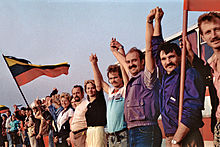Baltic way
The Baltic Way ( Lithuanian Baltijos kelias , Latvian Baltijas ceļš , Estonian Balti kett , the latter literally Baltic chain ) was a 650 km (according to other information: 595 km) human chain in the Baltic States on August 23, 1989.
prehistory
On August 23, 1989, on the occasion of the Hitler-Stalin Pact, Baltic dissidents and members of the Helsinki Group addressed the public in the "Baltic Appeal" in order to have the pact published and subsequently canceled. There was no Western support and the signatories were persecuted. In 1986 the Latvian dissident group Helsinki-86 demanded the publication and annulment of the treaty and suggested joint Baltic protests for the 1987 anniversary. While Estonians, Latvians and Lithuanians initially addressed supposedly apolitical ecological issues such as phosphorite mining in Northern Estonia, the construction of the Riga Metro or the Lithuanian nuclear power plant Ignalina during perestroika, the Singing Revolution and the Baltic Popular Front movements created an independence movement that takes place on every anniversary of the Pact organized larger demonstrations.
occasion
On the occasion of the 50th anniversary of the Hitler-Stalin Pact, over a million Estonians, Latvians and Lithuanians in the three countries formed a human chain to demonstrate their unity in the drive for freedom and independence from the Soviet Union. The popular front movements called Rahvarinne (Estonia), Tautas Fronte (Latvia) and the Lithuanian Sajudis . In Lithuania alone, 1.2 million people signed the Baltic appeal to the Federal Republic, the GDR, the Soviet Union and the UN to annul the entire German-Soviet treaty. The Central Committee of the CPSU condemned the demonstration as extremist and harmful to the Soviet people and drove the people into the arms of the Baltic independence advocates.
After the Hitler-Stalin Pact, its secret additional protocol and its German-Soviet border and friendship treaty , Estonia, Latvia and Lithuania fell to the Soviet Union . After the liquidation and incorporation of the Baltic states of Estonia, Latvia and Lithuania into the Soviet Union in June 1940, there were mass deportations , mainly of members of the bourgeois elite, to the forced labor camps of the Gulag. In 1945 and 1949 there were new mass deportations in the Baltic States and hundreds of thousands of Russian-speaking Soviet citizens were settled with the aim of Russifying the new republics .
The human chain reached from Vilnius in Lithuania via Riga in Latvia to Tallinn in Estonia . It is the longest known human chain in history.
souvenir
The states commemorated the Baltic Way with monuments and commemorative coins. In addition, documents were Baltic Way in 2009 in the World Documentary Heritage of UNESCO added.
Memorial monument in Estonia
Postage stamp in Lithuania
1- Litas commemorative coin for the 10th anniversary
Video chronicles
literature
- Karsten Brüggemann : Human chain through the Baltic States. In: Listen and Look . Journal of the Memorial Museum in the Runden Ecke Leipzig, 25th year, issue 82–83, 1–2 / 2016, pp. 43–47.
- "Lietuva 1940-1990. Okupuotos Lietuvos istorija ”. Lietuvos gyventojų genocido ir rezistencijos tyrimo centras. Vilnius 2005 mp 617-619.
- Visuotinė lietuvių enciklopedija . Mokslo ir enciklopedijų Leidybos institutas. Vilnius 2002. T. II. "Baltijos kelias".
- "Baltijos kelias" - kelias į laisvę. Dešimtmetį minint. Lietuvos Sąjūdis, Romas Batūra. Vilnius 1999. p. 14-16, 24-27, 44-45.
Web links
- The trilingual song "Atmostas Baltija (Latvian) / Bunda Jau Baltija (Lithuanian) / Ärgake Baltimaad (Estonian)" - in German "the Baltic is waking up"
- Video of the Baltic Way on YouTube
Individual evidence
- ↑ Jan Lipinsky: The history of the reception of the Hitler-Stalin Pact in East Central Europe . In: The Hitler-Stalin Pact 1939 in the cultures of remembrance of the Europeans . Wallstein, Göttingen 2011, p. 69 f.
- ^ Karsten Brüggemann: Estonia and the end of the Soviet Union . In: The Hitler-Stalin Pact 1939 in the cultures of remembrance of the Europeans . Wallstein, Göttingen 2011, p. 303 f.
- ^ A b The Baltic Way - Human Chain Linking Three States in Their Drive for Freedom . In: UNESCO . Retrieved August 19, 2012.
- ↑ a b Deutsche Welle: The "Singing Revolution" , 23 August 2009
- ↑ Jan Lipinsky: The Secret Additional Protocol to the German-Soviet Non-Aggression Treaty of August 23, 1939 and its history and reception history from 1939 to 1999 . Peter Lang 2000, ISBN 3-631-52322-X , p. 458 f.
- ^ Karsten Brüggemann: Estonia and the end of the Soviet Union . P. 313.
- ↑ Boris Meissner : The Soviet Union, the Baltic States and international law. Verlag für Politik u. Economy, Cologne 1956, XI, 377.
- ↑ Mart Laar : Estonia and Communism. In: The Black Book of Communism 2 . Munich 2004, pp. 261–323.
- ↑ BPB, 30 years ago: Human chain "Baltic Way" , August 19, 2019







